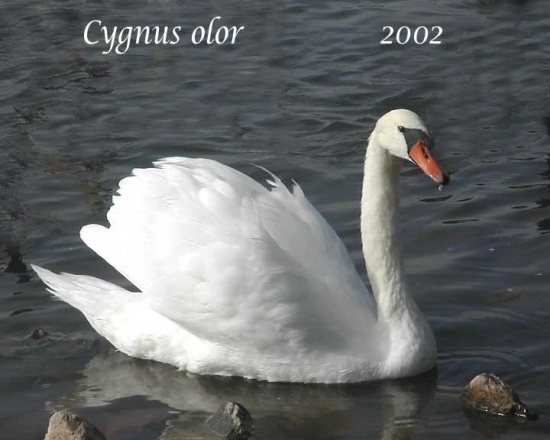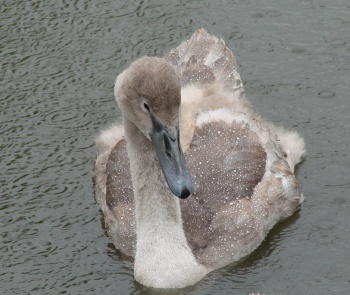(Added Photo) |
|||
| (17 intermediate revisions by 3 users not shown) | |||
| Line 1: | Line 1: | ||
| − | + | [[Image:Mute_Swan.jpg|thumb|550px|right|Photo by {{user|Marysan|Marysan}}<br />Lake Murray, San Diego, [[California]], [[USA]]]] | |
| − | [[Image:Mute_Swan.jpg|thumb|550px|right|Photo by {{user|Marysan|Marysan}}<br /> | ||
;[[:Category:Cygnus|Cygnus]] olor | ;[[:Category:Cygnus|Cygnus]] olor | ||
==Identification== | ==Identification== | ||
*L. 127-152 cm (50-60 in) | *L. 127-152 cm (50-60 in) | ||
*W. 208-238 cm (82-94 in) | *W. 208-238 cm (82-94 in) | ||
| − | * | + | *Wt. 5500-14300 g (12-31 lbs) |
====Adult==== | ====Adult==== | ||
| + | [[Image:Mute_swan_juv.jpg|thumb|350px|right|Juvenile<br />Photo by {{user|ody|ody}}<br />Alblasserdam, [[Holland]]]] | ||
*White plumage | *White plumage | ||
*Bright orange bill with black knob at base | *Bright orange bill with black knob at base | ||
*Male larger, with larger knob | *Male larger, with larger knob | ||
====Juvenile==== | ====Juvenile==== | ||
| − | *Dull, greyish-brown | + | *Dull, greyish-brown, or in some areas, almost white |
*Grey bill without knob | *Grey bill without knob | ||
| − | |||
==Distribution== | ==Distribution== | ||
| − | + | A native of northern and central [[Eurasia]]. It is a common resident throughout lowland [[British Isles]], north and central [[France]] and east to [[Denmark]] and [[Germany]]. A summer visitor to southern [[Norway]], southern [[Sweden]] and extreme south [[Finland]] and [[Poland]] and the [[Baltic States]]. Also breeds around the northern shores of the Black and Caspian Seas and in parts of [[Turkey]]. | |
| − | + | In the west most are descended from introduced or feral birds and in [[Britain]] especially, live in close association with man. Bred ferally in [[Iceland]] in the 1960s but extinct since 1977. | |
| + | |||
| + | '''Vagrant''' to Iceland and the [[Faroes]], [[Morocco]], [[Spain]] and the [[Canary Islands]], Mediterranean islands and the [[Azores]]. | ||
| + | [[Image:DSC 2030.JPG|thumb|350px|right|Female Mute Swan with cygnets,<br />Photo by {{user|Andy_Hurley|Andy Hurley}}<br />RSPB Lodmoor, [[England]], <br />May 2012]] | ||
| + | |||
| + | Birds found anywhere else in the world, have been intoduced as an ornamental species in parks and estates. In [[North America]] escaped birds have established feral populations in many areas, particularly around the Great Lakes and along the Atlantic coast. Their aggressive behaviour can threaten native waterfowl species and some states are trying to control this species | ||
==Taxonomy== | ==Taxonomy== | ||
| + | This is a [[Dictionary_M-O#M|monotypic]] species<sup>[[#References|1]]</sup>. | ||
| + | |||
==Habitat== | ==Habitat== | ||
| − | + | Breeds in town parks, flooded gravel-pits, reservoirs and natural wetlands, as well as in protected bays with brackish to salty water. Slow-flowing rivers and large, shallow lakes, often in estuaries and on sheltered coasts out of the breeding season. | |
==Behaviour== | ==Behaviour== | ||
| + | It is a very aggressive bird, especially during the breeding season | ||
| + | ====Movement==== | ||
| + | Often swims with it's wings arched and it's neck in an S-curve, giving it a very graceful appearance. The neck is fully outstretched in flight | ||
| + | ====Breeding==== | ||
| + | The Mute Swan mates for life, but if one of the pair should die, the other will remate. | ||
| + | |||
| + | The nest is a large mound of vegetation; reeds, grass and other water plants, including seaweed for coastal populations. It is either built on an island or a well vegetated reedy bank. They lay from 5-9 large, greenish-white eggs, usually during April in the UK | ||
====Diet==== | ====Diet==== | ||
| − | + | They eat a variety of aquatic plants, grass and grain. They feed by tipping up like a dabbling duck. | |
====Vocalisation==== | ====Vocalisation==== | ||
| + | Generally silent, but does make hissing and grunting noises. In addition, the sound of the wings in flight is characteristic if one is close enough to hear it.<br /> | ||
<flashmp3>Cygnus olor (song).mp3</flashmp3><br /> | <flashmp3>Cygnus olor (song).mp3</flashmp3><br /> | ||
''[[Media:Cygnus olor (song).mp3|Listen in an external program]]'' | ''[[Media:Cygnus olor (song).mp3|Listen in an external program]]'' | ||
| + | ==In Culture== | ||
| + | In the UK the Crown owns all unmarked Mute Swans on the River Thames. An annual census (called Swan-upping) is carried out in July, to mark, count and check the health of the population. | ||
| + | ==References== | ||
| + | #{{Ref-Clements6thAug16}}#The Royal Windsor Website | ||
| + | #Collins Pocket Guide to British Birds 1966 | ||
| + | #Collins Bird Guide ISBN 0 00 219728 6 | ||
| + | #The Observer's Book of Birds' Eggs ISBN 0723200602 | ||
| + | {{ref}} | ||
==External Links== | ==External Links== | ||
{{GSearch|Cygnus+olor}} | {{GSearch|Cygnus+olor}} | ||
| − | + | <br /> | |
| − | [[Category:Birds]][[Category:Cygnus]][[Category:Bird Songs]] | + | {{Video|Mute_Swan}} |
| + | |||
| + | [[Category:Birds]][[Category:Cygnus]][[Category:Bird Songs]][[Category:Videos]] | ||
Revision as of 09:44, 4 February 2017
- Cygnus olor
Identification
- L. 127-152 cm (50-60 in)
- W. 208-238 cm (82-94 in)
- Wt. 5500-14300 g (12-31 lbs)
Adult
- White plumage
- Bright orange bill with black knob at base
- Male larger, with larger knob
Juvenile
- Dull, greyish-brown, or in some areas, almost white
- Grey bill without knob
Distribution
A native of northern and central Eurasia. It is a common resident throughout lowland British Isles, north and central France and east to Denmark and Germany. A summer visitor to southern Norway, southern Sweden and extreme south Finland and Poland and the Baltic States. Also breeds around the northern shores of the Black and Caspian Seas and in parts of Turkey.
In the west most are descended from introduced or feral birds and in Britain especially, live in close association with man. Bred ferally in Iceland in the 1960s but extinct since 1977.
Vagrant to Iceland and the Faroes, Morocco, Spain and the Canary Islands, Mediterranean islands and the Azores.
Birds found anywhere else in the world, have been intoduced as an ornamental species in parks and estates. In North America escaped birds have established feral populations in many areas, particularly around the Great Lakes and along the Atlantic coast. Their aggressive behaviour can threaten native waterfowl species and some states are trying to control this species
Taxonomy
Habitat
Breeds in town parks, flooded gravel-pits, reservoirs and natural wetlands, as well as in protected bays with brackish to salty water. Slow-flowing rivers and large, shallow lakes, often in estuaries and on sheltered coasts out of the breeding season.
Behaviour
It is a very aggressive bird, especially during the breeding season
Movement
Often swims with it's wings arched and it's neck in an S-curve, giving it a very graceful appearance. The neck is fully outstretched in flight
Breeding
The Mute Swan mates for life, but if one of the pair should die, the other will remate.
The nest is a large mound of vegetation; reeds, grass and other water plants, including seaweed for coastal populations. It is either built on an island or a well vegetated reedy bank. They lay from 5-9 large, greenish-white eggs, usually during April in the UK
Diet
They eat a variety of aquatic plants, grass and grain. They feed by tipping up like a dabbling duck.
Vocalisation
Generally silent, but does make hissing and grunting noises. In addition, the sound of the wings in flight is characteristic if one is close enough to hear it.
<flashmp3>Cygnus olor (song).mp3</flashmp3>
Listen in an external program
In Culture
In the UK the Crown owns all unmarked Mute Swans on the River Thames. An annual census (called Swan-upping) is carried out in July, to mark, count and check the health of the population.
References
- Clements, J. F., T. S. Schulenberg, M. J. Iliff, D. Roberson, T. A. Fredericks, B. L. Sullivan, and C. L. Wood. 2016. The eBird/Clements checklist of birds of the world: v2016, with updates to August 2016. Downloaded from http://www.birds.cornell.edu/clementschecklist/download/
- The Royal Windsor Website
- Collins Pocket Guide to British Birds 1966
- Collins Bird Guide ISBN 0 00 219728 6
- The Observer's Book of Birds' Eggs ISBN 0723200602
Recommended Citation
- BirdForum Opus contributors. (2024) Mute Swan. In: BirdForum, the forum for wild birds and birding. Retrieved 23 April 2024 from https://www.birdforum.net/opus/Mute_Swan
External Links






